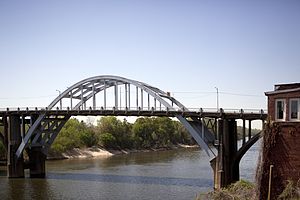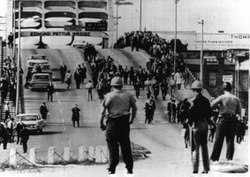Edmund Pettus Bridge
Edmund Pettus Bridge | |
|---|---|
 The central span of the Edmund Pettus Bridge in 2010. | |
| Coordinates | 32°24′20″N 87°01′07″W / 32.40556°N 87.01861°W |
Edmund Pettus Bridge | |
| Location | Selma, Alabama |
| Built | 1939 |
| NRHP reference No. | 13000281 |
| Added to NRHP | February 27, 2013[1] |
| Carries | |
| Crosses | Alabama River |
| Characteristics | |
| Design | Through arch bridge |
| Total length | 1,248.1 feet (380.4 m) |
| Width | 42.3 feet (12.9 m) |
| Longest span | 250 feet (76 m) |
| No. of spans | 7 |
| Piers in water | 4 |
| Clearance above | 14.8 feet (4.5 m) |
| History | |
| Construction start | 1939 |
| Construction end | 1940 |
| Opened | May 25, 1940 |
| Statistics | |
| Daily traffic | 17,720 |
| Location | |
 | |
The Edmund Pettus Bridge is a bridge that carries U.S. Route 80 across the Alabama River in Selma, Alabama. Built in 1940, it is named for Edmund Winston Pettus, a former Confederate brigadier general, U.S. Senator from Alabama and Grand Dragon of the Alabama Ku Klux Klan. The bridge is a steel through arch bridge with a central span of 250 feet (76 m).
The Pettus Bridge was the site of the conflict of Bloody Sunday on March 7, 1965, when armed officers attacked peaceful civil rights demonstrators attempting to march to the state capital of Montgomery.
The bridge was declared a National Historic Landmark on March 11, 2013.[2]
Edmund Winston Pettus
Edmund Winston Pettus was born in Limestone County, Alabama, to John Pettus and Alice Taylor Winston in 1821. He graduated from a public high school and attended Clinton College. He then went on to Tuscumbia, Alabama, to study law and was admitted into the state's bar association in 1842. In 1844 he was elected to serve in the seventh Judicial Circuit of Alabama as a solicitor. From 1847-1849 he served as a lieutenant with the Alabama Volunteers during the Mexican–American War. From 1854 he served as a judge in the seventh Judicial Circuit of Alabama, until resigning in 1858. After resigning as judge he went back to Selma, Alabama where he went back to practicing law. Following the outbreak of the American Civil War he served with the 20th Regiment Alabama Infantry, eventually attaining the rank of brigadier general in 1863 and being assigned a command in the Army of Tennessee. Following the war he resumed his law practice in Selma. At that time he also led the Alabama Ku Klux Klan. He was residing in Selma when he was elected as a United States Senator from Alabama in 1897 and 1903. He died in 1907.[3] Edmund's brother John was also an Alabama politician.
Civil Rights flashpoint
In 1965 voting rights for African Americans were a contentious issue. In Selma, Alabama, voting rolls were 99% White and 1% African American.[4] The case of Jimmie Lee Jackson showed how African Americans were treated; as state troopers and other locals started a fight with some 400 African American demonstrators, Jimmie Lee Jackson was shot in the stomach, and he died eight days later. As word reached the people, including Martin Luther King, Jr., SCLC civil rights activist James Bevel strategized a plan for a peaceful march on the state's capitol.[5] There were many acts just like this one that involved killings, and many more that involved economic and health problems.[6]

On March 7, 1965, armed officers attacked peaceful civil rights demonstrators attempting to march to the state capital of Montgomery in an incident that became known as Bloody Sunday.
As a result of this, Voting Rights Act made discriminatory voting practices illegal and put a stop to the persecution of the African Americans who had been working for the cause. Section 4 of the Act ended the requirement of literacy tests in six of the Southern states. These states included: Alabama, Georgia, Louisiana, Mississippi, and South Carolina.[7] Section 5 stated that no one could make a change to their voting rules unless first authorized by a three-judge court, the District of Columbia, or by the Attorney General of the United States.[7]On June 25, 2013, the United States Supreme Court held that it is unconstitutional to use the coverage formula in Section 4(b) of the Voting Rights Act to determine which jurisdictions are subject to the preclearance requirement of Section 5 of the Voting Rights Act, Shelby County v. Holder, 133 S. Ct. 2612 (2013). The Supreme Court did not rule on the constitutionality of Section 5 itself. The effect of the Shelby County decision is that the jurisdictions identified by the coverage formula in Section 4(b) no longer need to seek preclearance for the new voting changes, unless they are covered by a separate court order entered under Section 3(c) of the Voting Rights Act.[8]
Since 1965, many marches have commemorated the events of Bloody Sunday. On the 30th anniversary of that event, Rep. John Lewis, former president of SNCC and a prominent activist during the Selma to Montgomery marches, said, "It's gratifying to come back and see the changes that have occurred; to see the number of registered voters and the number of Black elected officials in the state of Alabama to be able to walk with other members of Congress that are African Americans."[9] Another notable day was the 40th reunion of Bloody Sunday, when over 10,000 people met to march across the Edmund Pettus Bridge again. Among those 10,000 people was, again, Rep. John Lewis, who was one of the men attacked on Bloody Sunday.[10] Also, in 1996, the Olympic torch made its way across the bridge with its carrier, Andrew Young, and many public officials, to symbolize how far the South has come. When Young spoke at the Brown Chapel A.M.E. Church, as part of the torch ceremony, he said, "We couldn't have gone to Atlanta with the Olympic Games if we hadn't come through Selma a long time ago."[11]
In popular culture
"Bloody Sunday", the first of the Selma to Montgomery marches, as well as the events of the second march, were re-enacted on the bridge and depicted in the 2014 film Selma.
References
- ^ "Edmund Pettus Bridge". National Register of Historic Places Program. National Park Service.
- ^ "AMERICA'S GREAT OUTDOORS: Secretary Salazar, Director Jarvis Designate 13 New National Historic Landmarks". US Department of the Interior. Retrieved 2013-03-11.
- ^ "PETTUS, Edmund Winston - Biographical Information". Bioguide.congress.gov. 1907-07-27. Retrieved 2010-08-22.
- ^ Friday, Mar. 19, 1965 (1965-03-19). "Nation: The Central Points". TIME. Retrieved 2010-08-22.
{{cite news}}: CS1 maint: multiple names: authors list (link) CS1 maint: numeric names: authors list (link) - ^ Friday, Mar. 19, 1965 (1965-03-19). "Nation: The Central Points". TIME. Retrieved 2010-08-22.
{{cite news}}: CS1 maint: multiple names: authors list (link) CS1 maint: numeric names: authors list (link) - ^ "We Shall Overcome - The Cost". Nps.gov. Retrieved 2010-08-22.
- ^ a b "Civil Rights Division Home Page". Justice.gov. 2008-07-25. Retrieved 2010-08-22.
- ^ United States Department of Justice website.
- ^ Jet - Google Books. Books.google.com. 1995-03-27. Retrieved 2010-08-22.
- ^ Jet - Google Books. Books.google.com. 2005-03-28. Retrieved 2010-08-22.
- ^ Heath, Thomas (1996-07-01). "After Three Decades, Selma Sees the Light; Torch Crosses Bridge Between Peace, Violence". Pqasb.pqarchiver.com. Retrieved 2010-08-22.


